Speech The Terms of Trade: Outlook and Implications

Alexandra Heath
[*]
Head of Economic Analysis Department
Resources and Energy Workshop hosted by the Department of Industry, Innovation and Science
Canberra –
The terms of trade will always be an important part of the macroeconomic landscape in a small open economy such as Australia. Since the mid 2000s, movements in the terms of trade have been particularly important because the cycle has been so large. As you can imagine, we've spent a lot of time thinking about forecasting the terms of trade and its implications for the rest of the economy. Today I'll focus on two questions: How good are we at forecasting the terms of trade? And, based on recent experience, what parts of the domestic economy are most likely to be directly affected by changes in the terms of trade?
How good are we at forecasting the terms of trade?
The simple answer is ‘not very’. This should not be a surprising answer because macroeconomic forecasting is difficult. One way the Bank acknowledges this is by placing confidence intervals around the forecasts for GDP, the unemployment rate and underlying inflation in our regular quarterly update of our forecasts in the Statement on Monetary Policy. Arguably, forecasting the terms of trade through this period has been particularly difficult given the unprecedented nature of the structural changes at work, most notably the increasing prominence of the Chinese economy and uncertainties around how long it would take for new commodity supplies to come to market.
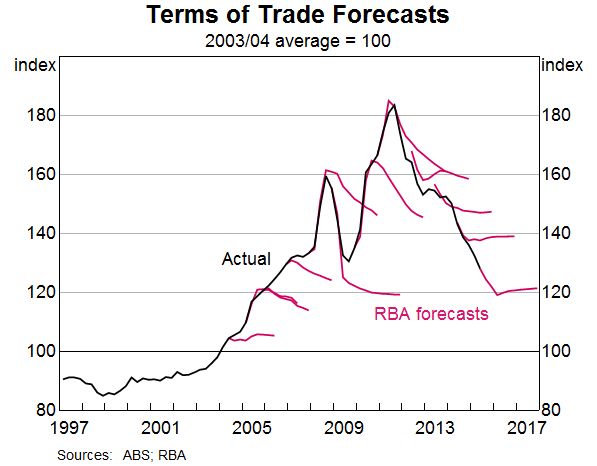
At the risk of oversimplifying, the task of forecasting the terms of trade for Australia is roughly equivalent to the task of forecasting commodity prices. A large part of the misses during the upswing of the terms of trade came down to an underappreciation of how much demand for commodities would grow, and how long it would take for new supply to come to market. After a long period of low commodity prices, there wasn't sufficient production capacity to meet the increase in demand from China and other emerging markets. Prices increased, and there was a substantial increase in mining investment around the world in response. In Australia, mining investment increased from around 2 per cent of GDP in the early 2000s to around 8 per cent in 2012. However, it takes some time for investment to translate into production, so, for a considerable period, growth in demand exceeded the increase in supply and commodity prices continued to increase. Over the past couple of years supply has been growing more rapidly than demand, as new capacity continues to come on line, and commodity prices have been falling. More recently, there has also been a noticeable slowdown in demand growth.
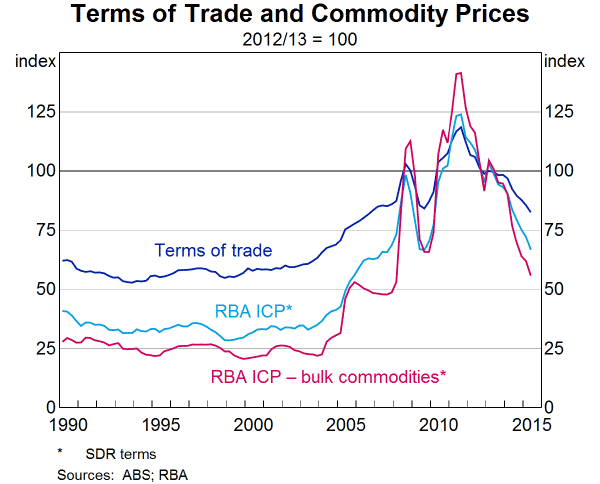
As discussed in our recent Statement on Monetary Policy, there is considerable uncertainty around how the forces of demand and supply will play out over the next few years, which leads to uncertainty about the outlook for the terms of trade. At the Bank, we monitor international developments, particularly those in China, to get a better understanding of how demand might evolve. On the supply side, we use our liaison program extensively to talk to participants in the mining industry and we use information on international production costs to inform our estimates of prices for bulk commodities. Another source of insights is the Department of Industry, Innovation and Science, which produces longer-term projections for the prices and volumes of bulk commodity and LNG exports.
Another source of information is financial market prices. At least in theory, spot financial prices should contain all the relevant information about supply and demand if these markets are reasonably deep and liquid. In this situation, it is difficult to do better than a ‘no-change’ assumption for price projections. However, theory also tells us that commodity markets have some special features that mean futures prices could provide additional information about current and expected supply and demand conditions.
Analysis at the Bank suggests that there is relatively little value in using something more sophisticated than the no-change assumption for many commodity prices. In other cases futures prices do appear to provide information about near-term price movements. Examples include, iron ore and oil. The development of the iron ore futures market is relatively recent, but oil futures markets have been relatively deep and liquid for some time. As the production of LNG ramps up over the next year or so, the projections for oil prices will become increasingly important for our terms of trade forecasts because Asian LNG pricing is closely linked to the oil price.
How do changes in the terms of trade affect the rest of the economy?
One of the most obvious consequences of the significant pick-up in commodity prices was an increase in mining investment. The increase in mining investment has led to a huge increase in the growth of resource exports. In each of the past 3 years, resource exports have contributed around 1 percentage point to GDP growth, compared to roughly a third of that in the preceding decade. This increase in resource exports has gone some way toward offsetting the drag on growth from the decline in mining investment since 2012.[1]
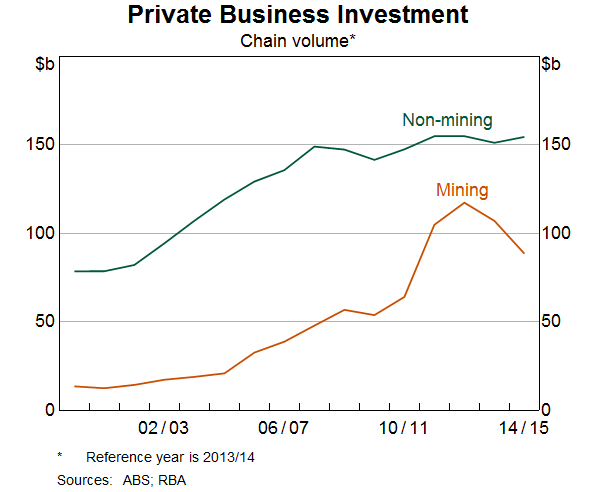
The reallocation of capital and labour to the mining sector was facilitated by some significant changes in relative prices. One of the most important relative price shifts was the appreciation of the Australian dollar that accompanied the rise in the terms of trade. One consequence of this was that non-mining firms producing tradable goods and services became less internationally competitive and so their demand for labour and capital inputs was less than it would have been otherwise.
Another direct consequence of higher commodity prices was that national income was able to grow faster than domestic production from 2003 to 2012. This allowed the mining sector to attract labour from other sectors of the economy by offering relatively high wages. Indeed, as the mining investment boom proceeded, wage growth in the mining sector picked up and there was clear evidence that wage growth was increasing in other parts of the economy, either because they were benefiting directly from the increase in demand for goods and services from the mining sector, or because they needed to pay more to retain or attract staff. The unemployment rate fell to levels not seen in Australia since the 1960s and early 1970s. Some of the increase in the demand for labour was accommodated through faster growth in the working-age population in Western Australia and Queensland, as a result of immigration from both other states and other countries.
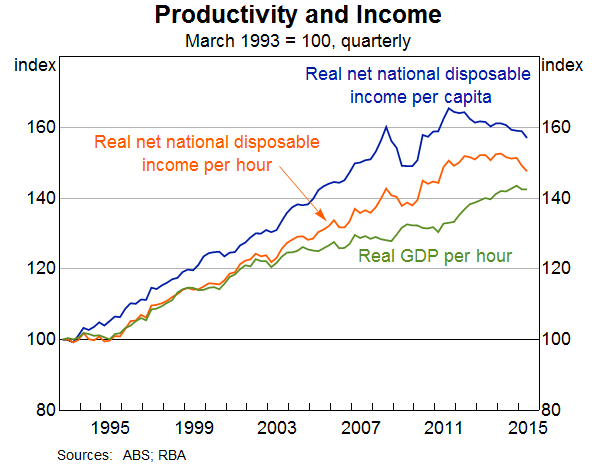
The appreciation of the exchange rate also helped to distribute the increase in income from the higher terms of trade by reducing the cost of imported goods. This benefitted most households and businesses that imported a significant share of their inputs. Some of the income gains were also distributed more widely through the economy by the Federal Government, which received more tax income. Estimates based on recent Bank research that uses the AUS-M model of the Australian economy suggest that household disposable income was 13 per cent higher by 2013 than it would have been without the increase in commodity prices and the associated mining boom (Downes, Hanslow, and Tulip, 2014).
Over this period, consumption grew more slowly than income and the household saving ratio increased significantly. Although the global financial crisis is likely to have accounted for some of the increase around 2008‑09, one interpretation of the longer-running increase in the household saving ratio is that households understood the boost to their real incomes from higher commodity prices was at least partly temporary, and saved some of the income to help them maintain their consumption when the terms of trade turned (Kulish and Rees, 2015). This interpretation is consistent with more recent developments that show the saving ratio has declined gradually over the past few years.
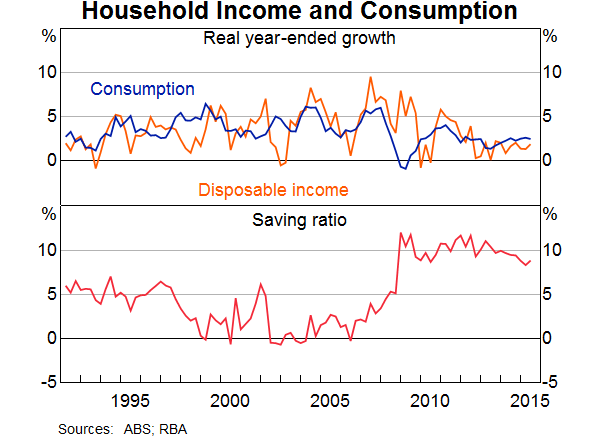
Indeed, many of the adjustments that occurred in the economy as the terms of trade rose have started to work in the opposite direction as the terms of trade have turned down. The exchange rate has depreciated, which has helped to improve the competitiveness of sectors producing tradable goods and services. The effect of this has been most noticeable for net service exports, which have been making similar contributions to growth as resource exports recently. The labour market has also adjusted. Demand for labour has picked up and wage growth has been very low. Employment growth has been driven by service industries over the past year or so and the unemployment rate has been lower over the course of this year than we had forecast a year ago. Growth in working-age population has fallen as a result of lower growth in net immigration. This has been most pronounced in Western Australia and Queensland, which have been most directly affected by the decline in mining investment and lower commodity prices.
Conclusion
To wrap up, I'll spend a few moments on how this episode compares to earlier ones. While current growth in the Australian economy is not as strong as we would like, the evidence from previous terms of trade cycles suggests that we have actually done quite well in aggregate. Although the unemployment rate has increased and there is clearly excess capacity in the labour market, it has not increased by as much as would be expected based on the experience of earlier episodes of significant structural change. Some of the explanation appears to be that the labour market has been more flexible and relative wage developments have facilitated the adjustment of labour between sectors. Unlike in previous episodes, we did not experience significant inflation, partly because the exchange rate appreciation helped to buffer the economy (Jääskelä and Smith, 2013), but also because inflation expectations remained anchored throughout the episode. This highlights the benefits of having a strong, credible macroeconomic policy framework and pursuing reforms that allow the economy to adapt and respond to changes in circumstances efficiently.
Endnote
I would like to thank Craig Evans for his help with preparing these remarks. [*]
The downturn in mining investment had been anticipated for some time because the most profitable investments were coming to completion and there had not been a sufficiently substantial change in technology to make it worthwhile bringing the next most profitable projects into the pipeline, particularly given that commodity prices had already started to fall. [1]
Bibliography
Jääskelä, J and P Smith (2013), ‘Terms of Trade Shocks: What are They and What Do they Do?’, Economic Record 89, pp 145-159.
Downes, P, K Hanslow and P Tulip (2014), ‘The Effect of the Mining Boom on the Australian Economy’, RDP 2014-08.
Kulish, M and D Rees (2015), ‘Unprecedented Changes in the Terms of Trade’, RDP 2015-11.
Atkin T, M Caputo, T Robinson and H Wang (2014), ‘Macroeconomic Consequences of Terms of Trade Episodes, Past and Present’, RDP 2014-01